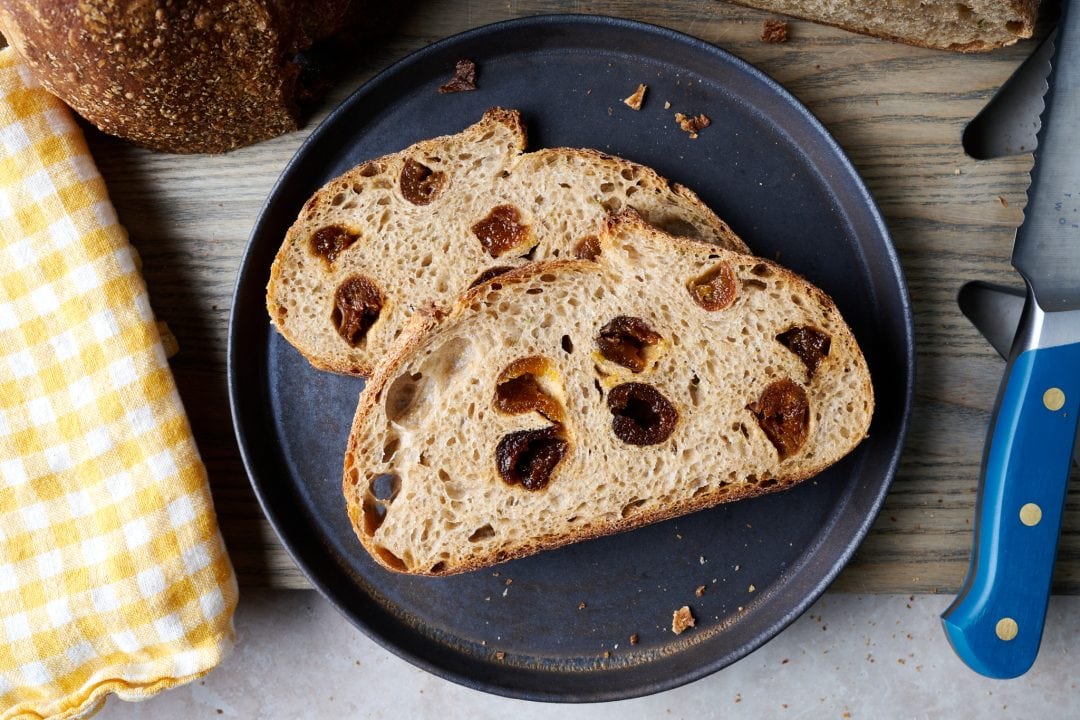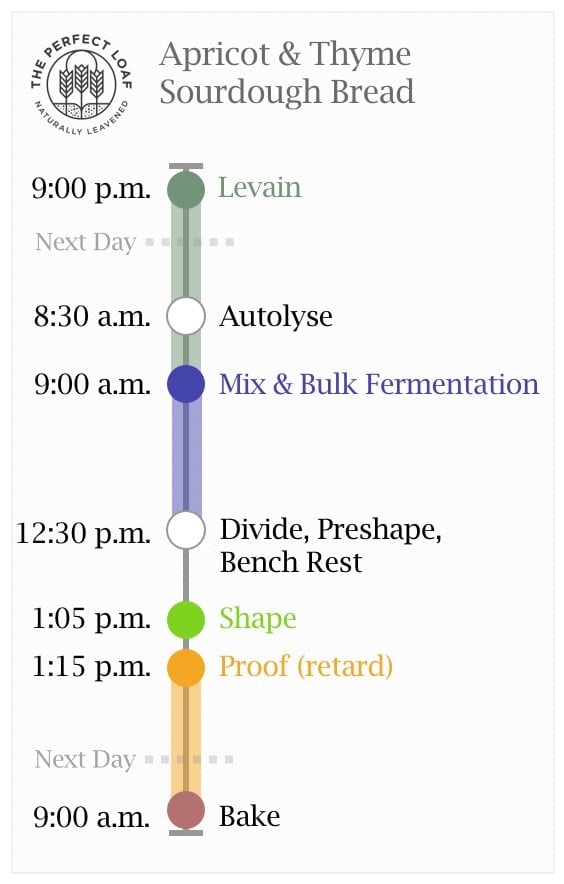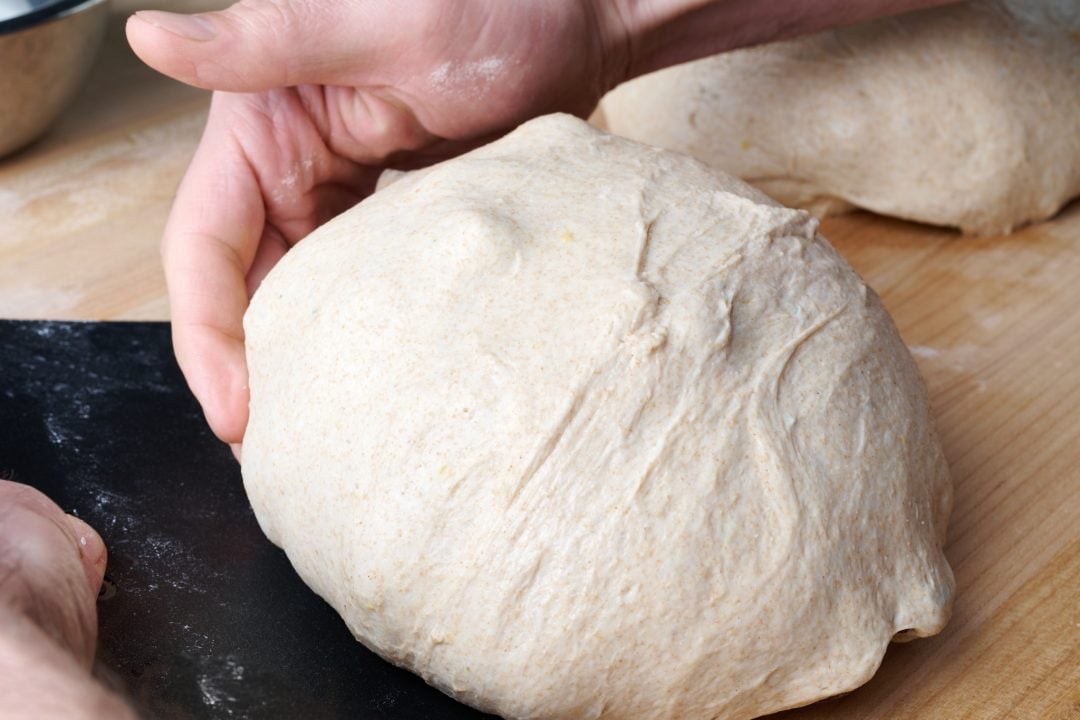Wintertime is when I rely on my larder just as much as the local market. The lack of fresh, juicy produce might be seen as a limitation by some, but for me, it’s a chance to get creative, to push the boundaries in my cooking and baking, and to see what surprises lie in wait. And lately, this creativity has involved a combination of dried apricots, winter-friendly fresh thyme, and lemon zest—all paired with a hefty percentage of whole wheat. These ingredients make for a hearty apricot and thyme sourdough bread that’ll warm up any cold, winter day.
This bread has a beautiful bouquet from piquant herbs and bright lemon zest. After baking, it is a welcome affront to the senses as it whips you straight to spring with its fresh and earthy aroma that invites memories of garden strolls among buzzing bees, rich soil, and flowering herbs. This delicious apricot and thyme sourdough bread will no doubt carry me through the next few months of harsh snows, gray days, and early nights—and I hope it’ll bring a little sunshine to your kitchen, too.
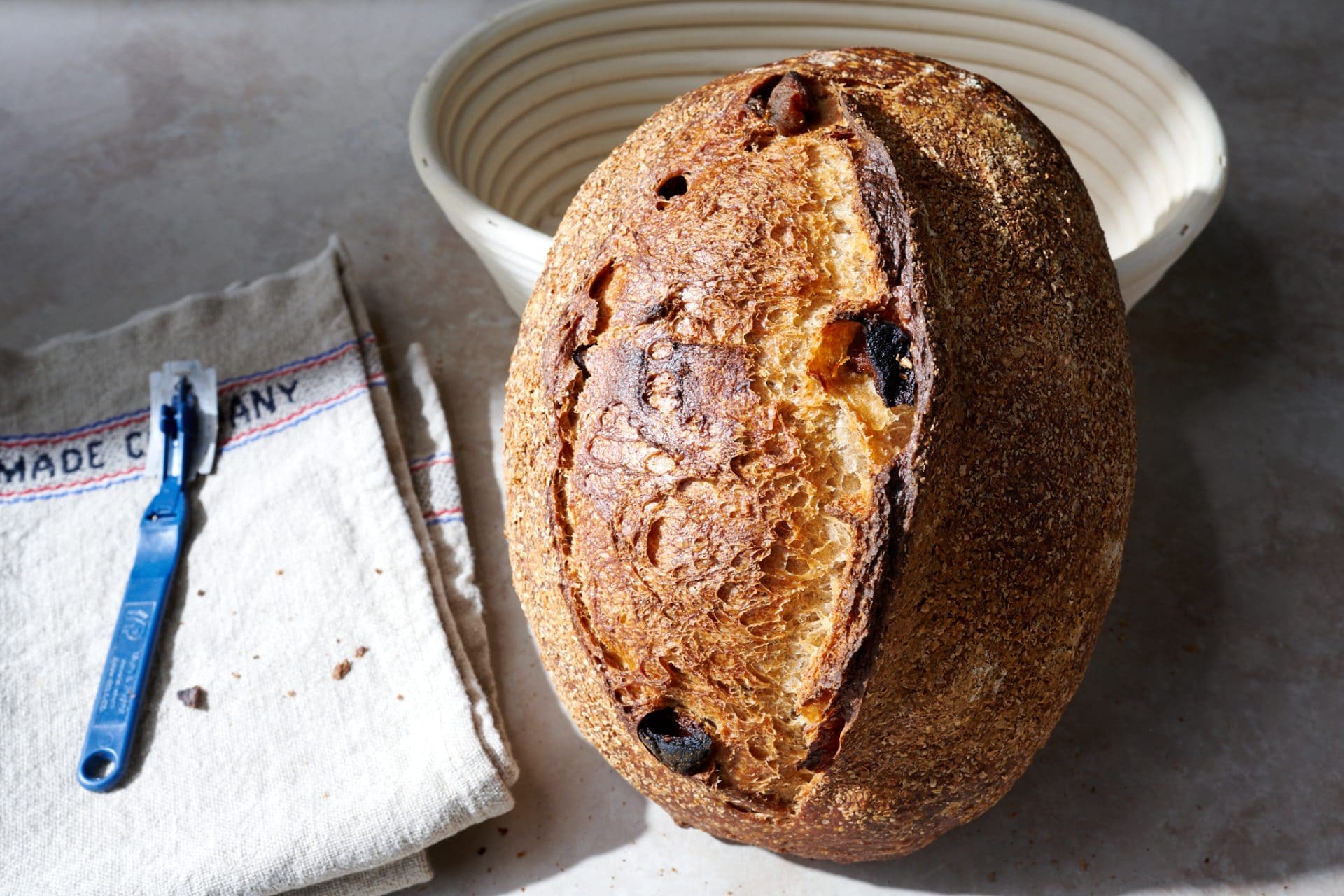
Flour and Ingredient Selection
I wanted this bread to have an assertive wheaty flavor, so half of the total flour is whole wheat. The earthy whole wheat is a wonderful backdrop for the sweet-sour flavor of dried apricots, which somehow reminds me of a slightly under-ripe summer peach.
This recipe was inspired by the apricot, and thyme preserves I make just about every late summer in an attempt to put to good use the bushels of ultra-ripe fruit from our family tree (if you have an apricot tree, you know what a mad rush it is to use them in just about everything). The Rosaceae-family fruit pairs so well with thyme it’s as if they were made to be matched—perhaps this is why you often see them together in foods across cultures (especially around Christmas time in stuffing).
The unsulfered, dried apricots I use for this recipe are always rather plump and moist, but if yours tend to be on the drier side, be sure to soak them in some of the dough mixing water overnight while your levain ripens (see the note in Step 1 of the recipe).
Baking Schedule
This apricot and thyme sourdough bread takes two days to make (not including the levain). The cold overnight proof gives the dough ample time to ferment, thus increasing the final fermentation flavors and making for a more manageable dough to score before baking.
To switch this to a direct bake (i.e. to bake it the same day it’s mixed), leave the dough out to proof on the counter for 2 to 3 hours until it passes the poke test (a finger poke springs slowly back). In the winter, my dough typically requires the full 3-hour final proof if done on the counter.
See my guide on baking bread in the winter for tips on how to keep your dough warm and the fermentation on schedule.
Apricot and Thyme Sourdough Bread Formula
Vitals
| Total dough weight | 1,800 grams |
| Pre-fermented flour | 9.0% |
| Hydration | 77.0% |
| Levain in the final dough | 20.8% |
| Yield | Two loaves |
Total Formula
Desired dough temperature: 78°F (25°C) (see my post on the importance of dough temperature).
| Weight | Ingredient | Baker’s percentage |
|---|---|---|
| 449g | White flour (about 11.5% protein; Central Milling Artisan Baker’s Craft) | 50.0% |
| 449g | Whole wheat flour (Central Milling Hi-Pro Whole Wheat) | 50.0% |
| 180g | Dried apricots, coarsely chopped | 20.0% |
| 2g | Fresh thyme, finely chopped (about ½ tablespoon) | 0.25% |
| 2g | Lemon zest (about 1 lemon) | 0.25% |
| 629g | Water 1 (levain and autolyse) | 70.0% |
| 63g | Water 2 (mix) | 7.0% |
| 16g | Fine sea salt | 1.8% |
| 8g | Ripe sourdough starter, 100% hydration | 0.9% |
If you don’t have medium-protein white flour, you can substitute it for high-protein white flour (“bread flour”) and still achieve the same results.
Apricot and Thyme Sourdough Bread Method
1. Prepare the apricots and levain – 9:00 p.m., the night before mixing
If your dried apricots are very dry, place them in a small bowl with 50 grams of water, cover the bowl, and let soak overnight while the levain ripens. Note that this water will be drained before adding the apricots during bulk fermentation.
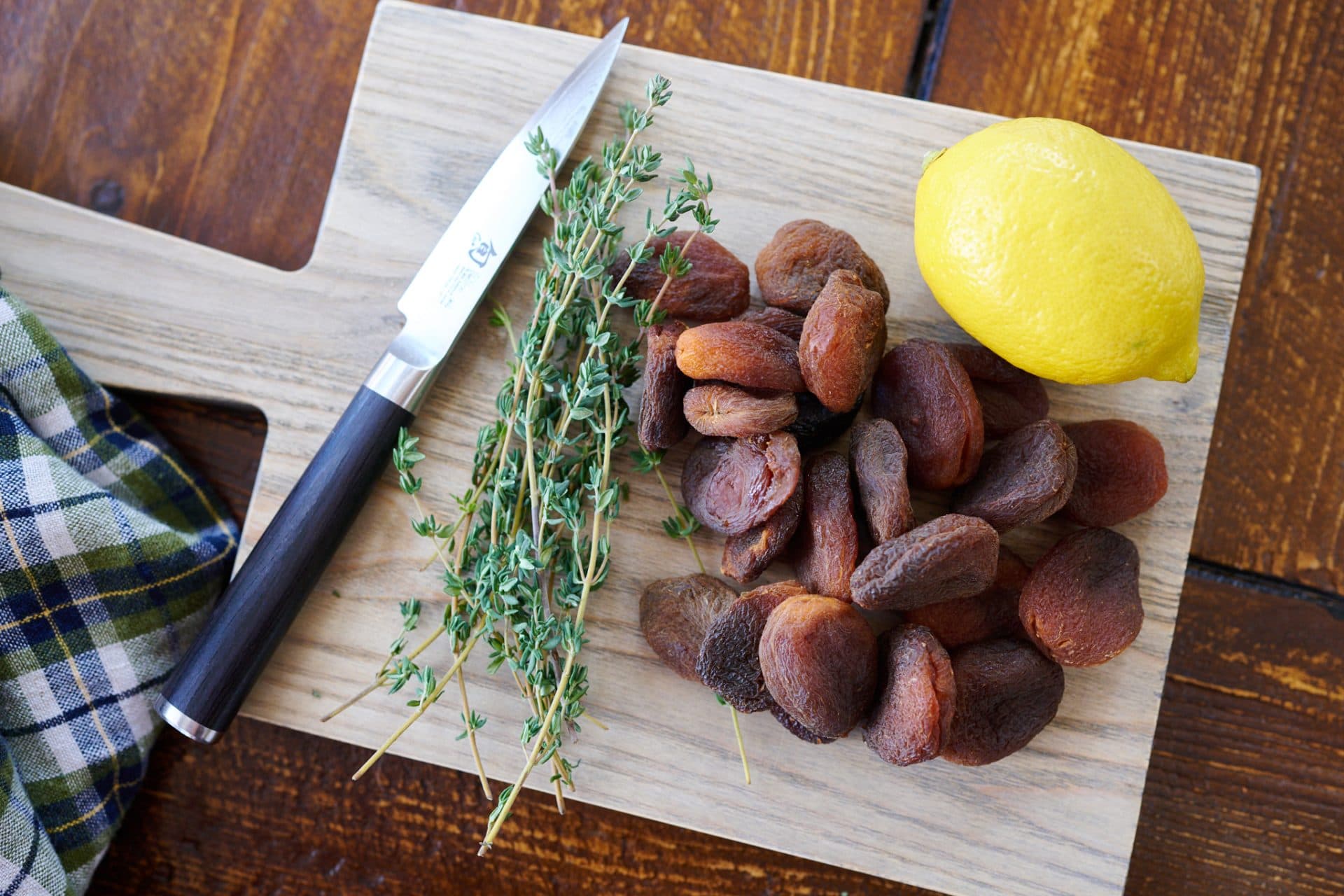
Mix the following ingredients in a container and leave them covered at a warm temperature, 74-76°F (23-24°C), to ripen overnight.
| Weight | Ingredient | Baker’s percentage |
|---|---|---|
| 40g | White flour | 50.0% |
| 40g | Whole wheat flour | 50.0% |
| 80g | Water 1 | 100.0% |
| 8g | Ripe sourdough starter, 100% hydration | 10.0% |
2. Autolyse – 8:30 a.m.
This recipe calls for a short autolyse to help shorten the necessary hand-mixing time.
Mix the following ingredients in a large bowl until incorporated. Cover and let rest for 30 minutes.
| Weight | Ingredient |
|---|---|
| 409g | White flour |
| 409g | Whole wheat flour |
| 548g | Water 1 |
3. Mix – 9:00 a.m.
I mixed and strengthened this dough by hand using the slap and fold technique, but you could also use a KitchenAid stand mixer or a large spiral mixer.
| Weight | Ingredient |
|---|---|
| 2g | Fresh thyme, finely chopped |
| 2g | Lemon zest (about 1 lemon) |
| 63g | Water 2 |
| 16g | Fine sea salt |
| 169g | Ripe levain (from Step 1) |
Add the about half the water, salt, and levain to the top of the dough that was just in autolyse. With wet hands, mix thoroughly. Next, mix and knead the dough for about 5 minutes until the dough smoothed and became elastic.
Add the thyme, lemon zest, and, if it feels like the dough can handle it, the remaining water. Mix by pinching and folding until the ingredients are thoroughly incorporated and the dough is cohesive. Transfer the dough back to the bowl or to a container for bulk fermentation and cover.
4. Bulk Fermentation – 9:30 a.m. to 12:30 p.m. (3 hours)
At a warm room temperature, 74-76°F (23-24°C), bulk fermentation should take about 3 hours. If your kitchen is cooler, place your bulk container in a small home dough proofer, or extend the bulk fermentation time to give the dough more time to ferment. The dough is ready when it is smooth, puffy, and well-risen.
If you soaked the apricots in water, drain them.
This dough requires 2 sets of stretches and folds during bulk fermentation. After the first 30 minutes, spread about one-quarter of the chopped apricots over the top of the dough. Wet your hands, grab the side of the dough farthest from you, and stretch it up and over to the other side. Next, spread on another one-quarter of the inclusions. Rotate the bowl 180-degrees and perform another stretch and fold. Next, spread on another one-quarter of the inclusions, rotate the bowl 90-degrees, and do another stretch and fold. Finally, spread on the last of the inclusions, turn the bowl 180-degrees, and do one last stretch and fold. The dough should be neatly folded up in the bowl.


Perform one more set of stretches and folds 30-minutes after the first. Then let the dough rest, covered, for the remainder of bulk fermentation.
5. Divide and Preshape – 12:30 p.m.
After 3 hours, the dough should be well-risen in the bulk fermentation container and be puffy to the touch. This is a relatively strong dough at this point in the process, so it doesn’t need a heavy hand when preshaping.
Fill a small bowl with water and place it next to your work surface. Scrape the dough onto a clean counter. Divide the dough into 2 equal pieces. Then, preshape each piece into a round.
To reduce burning on the exterior, if you see any pieces of apricot hanging onto the top or sides of the preshaped rounds, pluck them out and put them under the dough (which will end up being the inside of the loaf when you bake).
Let the dough rest, uncovered, for 35 minutes.
6. Shape – 1:05 p.m.
Line two proofing baskets with clean kitchen towels. Dust lightly and evenly with white flour.
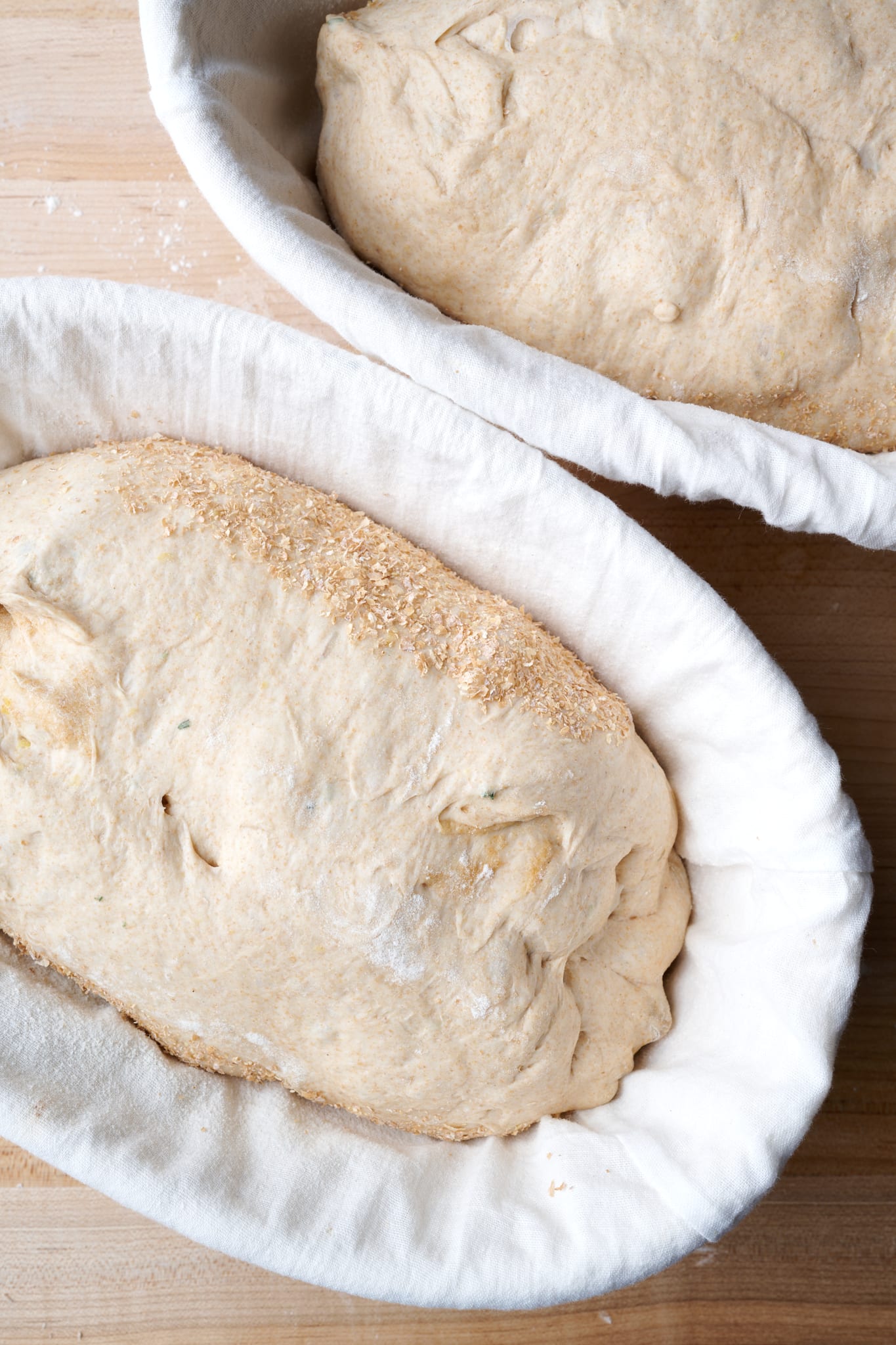
Flour the top of each preshaped round and your work surface. Using your bench knife, flip one round over onto the floured area. Using floured hands, shape the round into a batard shape (oval). I decided to roll my dough in raw wheat germ for added texture and visual appeal. (See my guide to topping bread dough for more ideas). Transfer the shaped dough to a proofing basket, seam side up.
Repeat with the other preshaped round.
7. Proof – 1:15 p.m. to 9:00 a.m.
Cover the baskets with a large, reusable plastic bag and seal. Place the baskets in the refrigerator to proof overnight.
8. Bake – 9:00 a.m., The Next Day
Place an oven rack in the bottom-third of the oven with no rack above it. Put a Dutch oven, combo cooker, Challenger bread pan, or baking stone/steel on the rack. Preheat the oven to 450°F (230°C) for 30 minutes if using a pot or 1 hour if using a baking surface.
I baked these loaves in my Challenger bread pan, but you could also follow my guide to steaming an oven for baking bread.
Take one of the proofing baskets out of the fridge, uncover it, and put a piece of parchment paper over the basket. Place a pizza peel or inverted sheet pan on top of the parchment and, using both hands, flip everything over. Gently remove the basket and score the dough.
Slide the dough into the oven. Steam the oven: either cover the Dutch oven or Challenger bread pan or pour ice into the preheated pan at the bottom of the oven. Bake for 20 minutes. Vent the oven of steam: either uncover the Dutch oven and remove the lid or remove the steaming pans. Continue to bake for 30 minutes more. When done, the loaf should have an internal temperature of around 204°F (95°C), and the crust should be deeply colored.
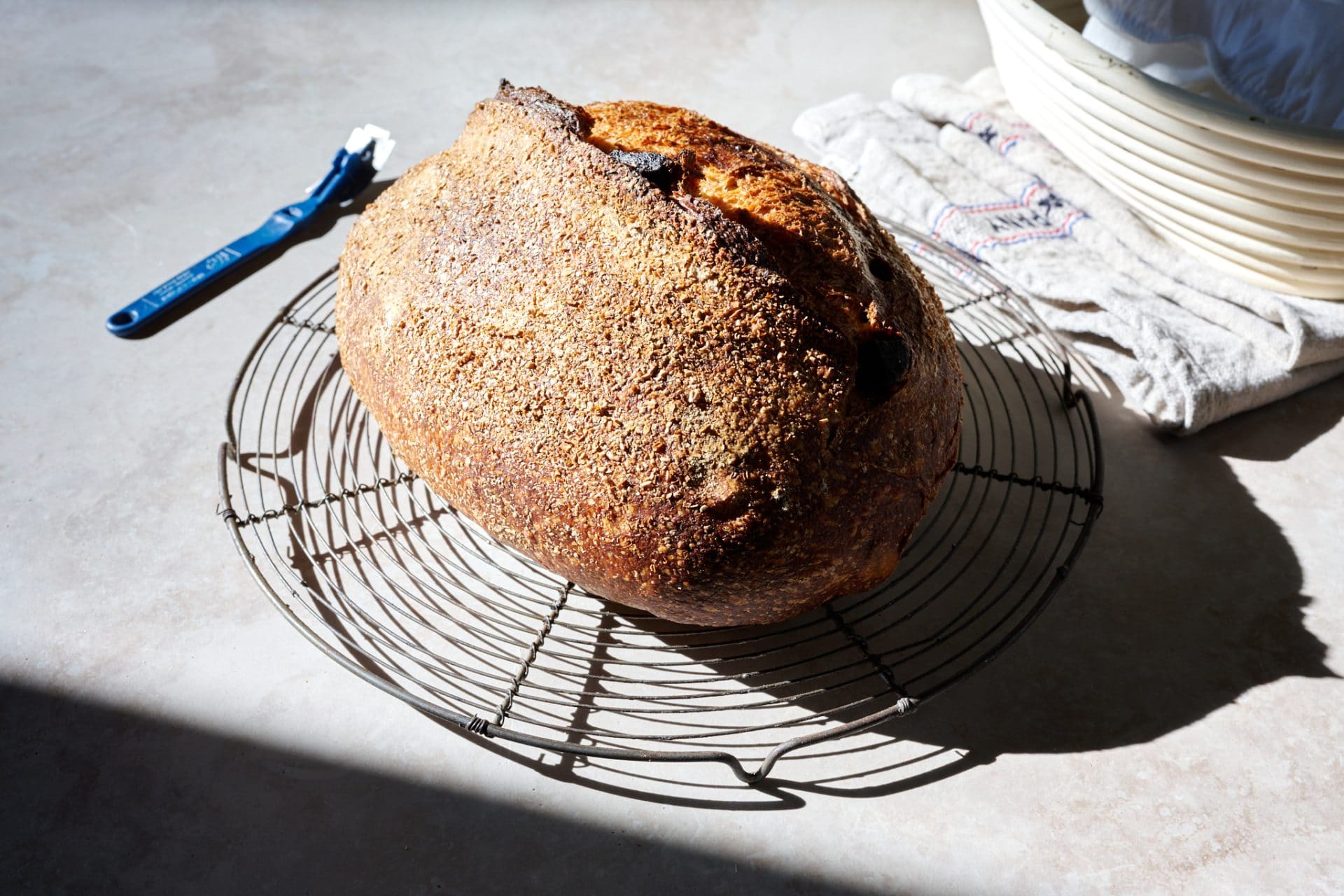
Let the loaves cool on a wire rack for 1 to 2 hours before slicing. See my post on the best way to store bread to keep it fresh for a week or longer.
Print
Apricot & thyme sourdough bread
- Author: Maurizio Leo
- Prep Time: 24 hours
- Cook Time: 50 minutes
- Total Time: 24 hours 50 minutes
- Yield: 2 loaves
- Category: Bread, Sourdough
- Cuisine: American
Description
This apricot and thyme sourdough bread is a winter-friendly recipe that incorporates fresh thyme, dried apricots, a little lemon zest, and a large percentage of whole wheat. The result is a hearty bread that’s a touch sweet, bright, and nourishing.
Ingredients
Levain
- 40g white flour (about 11.5% protein)
- 40g whole wheat flour
- 8g ripe sourdough starter, 100% hydration
- 80g grams water
Main dough
- 409g white flour (about 11.5% protein)
- 409g whole wheat flour
- 180g dried apricots
- 2g fresh thyme, minced
- 2g lemon zest
- 548g water 1
- 63g water 2
- 16g salt
Instructions
- Levain (9:00 p.m.)
In a small bowl or jar, mix the Levain ingredients. Cover the jar and keep it at a warm temperature for 12 hours. - Autolyse (8:30 a.m)
In a mixing bowl, add the flour and water 1 and mix until no dry bits remain. Cover the bowl and let rest for 30-minutes. - Mix (9:00 a.m.)
Add the about half the water 2, salt, and levain to the top of the dough that was just in autolyse. With wet hands, mix thoroughly. Next, knead the dough for a few minutes until elastic and slightly smooth. Add the thyme, lemon zest, and, if it feels like the dough can handle it, the remaining water 2. Mix by pinching and folding until the ingredients are thoroughly incorporated and the dough is cohesive. Transfer the dough back to the bowl or to a container for bulk fermentation and cover. - Bulk Fermentation (9:30 a.m. to 12:30 p.m.)
This dough will need 2 sets of stretches and folds during bulk fermentation where the first set starts after 30 minutes into bulk fermentation and the subsequent sets are at 30-minute intervals. During the first set of stretches and folds, add the apricots you perform each stretch and fold. After the second set of stretches and folds, let the dough rest, covered, for the remainder of bulk fermentation. - Divide and Preshape (12:30 p.m.)
Use water and a wet hand or lightly flour your work surface (whichever you prefer) and scrape out your dough. Using your bench knife, divide the dough in half. Lightly shape each half into a round shape. Let the dough rest for 35 minutes, uncovered. - Shape (1:05 p.m.)
Lightly flour the top of your preshaped rounds and using floured hands, shape the dough into an oval (batard) or round (boule) shape, then place the dough in proofing baskets, seam side up. - Proof (1:15 p.m. to 9:00 a.m. the next day)
Cover proofing baskets with reusable plastic and seal. Then, place both baskets into the refrigerator and proof overnight. - Bake (The next day, 9:00 a.m.)
Preheat your oven with a baking surface or combo cooker/Dutch oven inside to 450°F (230°C). When the oven is preheated, remove your dough from the fridge, score it, and transfer it to the preheated baking surface or combo cooker. Bake for 20 minutes with steam. After this time, vent the steam in the oven or remove the lid (you can keep it in the oven or remove it) and continue to bake for 30 minutes longer. When done, the internal temperature should be around 204°F (95°C). Let the loaves cool for 2 hours on a wire rack before slicing.
Apricot and thyme sourdough bread frequently asked questions
Can I use fresh apricots instead of dried in this apricot and thyme sourdough bread?
I would not recommend it for this recipe. Fresh apricots will likely break apart, become mushy, and spread throughout the dough.
Should my apricots be unsulfered?
Either sulfered or unsulfered, dried apricots will work for this recipe. I prefer to use apricots that are not sweetened or treated in any other way, though.
Can I use other dried fruit instead of apricots?
You bet. I think dried, sweetened cherries would work very well with the thyme.
Can I bake this bread the same day and skip the overnight proof?
Yes. As discussed in the Baking Schedule section, don’t proof in the fridge as Step 7 instructs, but rather leave the dough out on the counter after shaping, covered, for 1 to 3 hours, depending on the temperature in your kitchen. It is ready to bake when a poke to the dough very slowly springs back, perhaps not completely filling back in the indentation.
What’s Next?
If you’re firmly in winter mode, check out a few more winter-inspired recipes:
Buon appetito!


